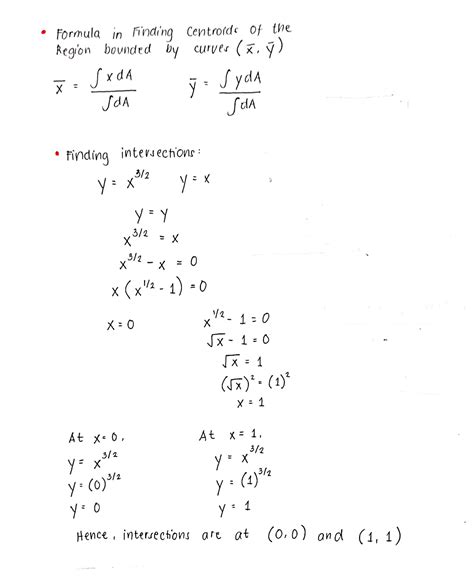Find The Centroid Of The Region Bounded By
News Co
Apr 08, 2025 · 5 min read

Table of Contents
Finding the Centroid of a Region: A Comprehensive Guide
Determining the centroid of a region is a fundamental concept in calculus and has numerous applications in physics, engineering, and computer graphics. The centroid, also known as the geometric center or center of mass, represents the average position of all the points within a given region. This article provides a comprehensive guide to finding the centroid of a region bounded by various curves, covering both single and double integrals, and incorporating practical examples.
Understanding the Centroid
Before diving into the calculations, let's establish a clear understanding of what a centroid represents. Imagine a thin, flat lamina (a two-dimensional shape) with uniform density. The centroid is the point where the lamina would balance perfectly if it were placed on a pin. This point represents the average x and y coordinates of all the points within the region.
For a region bounded by curves, we use integration to determine the centroid's coordinates. This process involves calculating the area of the region and then finding the weighted average of the x and y coordinates.
Mathematical Formulation
The coordinates of the centroid (x̄, ȳ) of a region R are given by the following formulas:
x̄ = (1/A) ∫∫<sub>R</sub> x dA
ȳ = (1/A) ∫∫<sub>R</sub> y dA
Where:
- A represents the area of the region R.
- dA represents an infinitesimally small area element within the region.
- ∫∫<sub>R</sub> denotes a double integral over the region R.
The area A can be calculated using a double integral:
A = ∫∫<sub>R</sub> dA
These formulas represent the weighted average of the x and y coordinates over the region. The double integral sums up the contributions of each infinitesimally small area element, weighted by its x and y coordinates.
Methods for Calculating the Centroid
The approach to calculating the centroid depends on how the region is defined. We will examine two common scenarios:
1. Region Bounded by Two Curves
Consider a region R bounded by two curves, y = f(x) and y = g(x), and the vertical lines x = a and x = b, where f(x) ≥ g(x) for all x in [a, b]. In this case, the formulas become:
A = ∫<sub>a</sub><sup>b</sup> [f(x) - g(x)] dx
x̄ = (1/A) ∫<sub>a</sub><sup>b</sup> x[f(x) - g(x)] dx
ȳ = (1/A) ∫<sub>a</sub><sup>b</sup> (1/2)[f(x)² - g(x)²] dx
2. Region Bounded by Polar Curves
For regions defined by polar curves, r = f(θ) and r = g(θ), where f(θ) ≥ g(θ) for θ ∈ [α, β], we use polar coordinates:
A = (1/2) ∫<sub>α</sub><sup>β</sup> [f(θ)² - g(θ)²] dθ
x̄ = (1/A) (1/2) ∫<sub>α</sub><sup>β</sup> [f(θ)² - g(θ)²]cos(θ) dθ
ȳ = (1/A) (1/2) ∫<sub>α</sub><sup>β</sup> [f(θ)² - g(θ)²]sin(θ) dθ
Practical Examples
Let's illustrate these concepts with several examples:
Example 1: Region bounded by y = x² and y = x
This region is bounded by the parabola y = x² and the line y = x. To find the intersection points, we set x² = x, which gives x = 0 and x = 1. Thus, a = 0 and b = 1.
-
A = ∫<sub>0</sub><sup>1</sup> (x - x²) dx = [x²/2 - x³/3]<sub>0</sub><sup>1</sup> = 1/6
-
x̄ = (6) ∫<sub>0</sub><sup>1</sup> x(x - x²) dx = 6[x³/3 - x⁴/4]<sub>0</sub><sup>1</sup> = 1/2
-
ȳ = (6) ∫<sub>0</sub><sup>1</sup> (1/2)(x² - x⁴) dx = 3[x³/3 - x⁵/5]<sub>0</sub><sup>1</sup> = 2/5
Therefore, the centroid is located at (1/2, 2/5).
Example 2: Region bounded by a circle
Consider a circle with radius 'r' centered at the origin. Using polar coordinates:
- A = πr² (The area of a circle)
Due to symmetry, the centroid of a circle lies at its center, (0,0). We can verify this using the polar coordinate formulas, but the symmetry argument makes the calculation unnecessary.
Example 3: Region bounded by y = √x and y = x
The curves intersect at (0,0) and (1,1).
-
A = ∫<sub>0</sub><sup>1</sup> (√x - x) dx = [2x³/2/3 - x²/2]<sub>0</sub><sup>1</sup> = 1/6
-
x̄ = (6) ∫<sub>0</sub><sup>1</sup> x(√x - x) dx = 6[2x⁵/2/5 - x³/3]<sub>0</sub><sup>1</sup> = 6(2/5 - 1/3) = 2/5
-
ȳ = (6) ∫<sub>0</sub><sup>1</sup> (1/2)(x - x²) dx = 3[x²/2 - x³/3]<sub>0</sub><sup>1</sup> = 1/2
Therefore, the centroid is at (2/5, 1/2).
Handling More Complex Regions
For more complex regions, dividing the region into simpler sub-regions might be necessary. Calculate the centroid of each sub-region separately, then find the weighted average of these centroids based on the area of each sub-region to determine the overall centroid. This approach is particularly helpful when dealing with regions defined by multiple curves or irregular shapes.
Applications of Centroid Calculation
The centroid calculation has a wide range of applications, including:
- Engineering: Determining the center of gravity for structural design and stability analysis.
- Physics: Calculating the center of mass of objects for mechanics problems.
- Computer Graphics: Finding the center of shapes for image processing and animation.
- Statistics: Calculating the mean of a probability distribution.
Conclusion
Finding the centroid of a region is a powerful technique with significant practical applications. Understanding the mathematical formulations and applying the appropriate integration methods allows for accurate determination of the centroid for various regions. By mastering these techniques, you can tackle complex geometric problems and apply the centroid concept to diverse fields. Remember to always carefully define the region's boundaries and choose the appropriate coordinate system (Cartesian or polar) for efficient calculation. Practice with various examples will solidify your understanding and enhance your problem-solving skills. This comprehensive guide provides a strong foundation for further exploration and application of centroid calculations.
Latest Posts
Related Post
Thank you for visiting our website which covers about Find The Centroid Of The Region Bounded By . We hope the information provided has been useful to you. Feel free to contact us if you have any questions or need further assistance. See you next time and don't miss to bookmark.